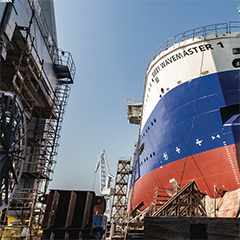Testing has been the name of the game for a while now. In the long run research design and testing helps save time and keep costs down. PES finds out first-hand how this worked for Damen, who turned to Maritime Research Institute Netherlands (MARIN) to test its pioneering Service Operations Vessel (SOV), together with the vessel’s Dynamic Positioning system and its walk-to-work telescopic gangway.
The Damen SOV is purpose built for the transfer and accommodation of offshore personnel and the ground breaking design guarantees fast, safe and comfortable access to wind turbines. The first vessel of this type, the Bibby WaveMaster 1, is expected to be available from end-August 2017.
Representing more than 4 years of Research and Development, the new SOV design underwent its initial seakeeping tests at MARIN’s Offshore Basin in Wageningen in the Netherlands to examine its DP capabilities during the turbine approach. Damen also asked MARIN to assess the power management system and the gangway through numerical simulations. The project resulted in an integrated HIL simulator, which has now been installed at Damen’s headquarters.
Jorinus Kalis, Manager Development, R&D at Damen explains: ‘Given that this was a completely new design, we wanted to test the vessel itself, but also the process behind it. We didn’t have any vessel type that came close to this new SOV so needed to know the functional requirements and look at the possibilities, considering the specific mission of the end user.
‘We had to think of a way of testing it to make sure the SOV has the right performance levels. Normally we would test separate systems before the trials – the engine and propeller, etc. – but we have never carried out combined tests on all of the control systems before.’
MARIN performed the basin tests in September 2015 to examine the SOV’s ability to approach and keep position alongside the turbines and to test the extension and touchdown of the walk-to-work arm.Auke Ditzel, MARIN Senior Project Manager, comments: ‘This enabled us to get the full picture about how the vessel responds when performing maintenance activities, the planned route between the turbine locations and the best way of getting the technicians safely on and off the turbines before moving on to the next turbine. We could see if the maintenance sequence could be done in a certain time, and how many turbines could be maintained in a certain number of hours.’
The measurements from the basin were then input into the HIL simulation software. Mr Ditzel emphasises: ‘We integrated the full DP system as it is used on board the Bibby Wavemaster 1 and the walk-to-work arm. This integrated setup is combined with the route planner.’



























